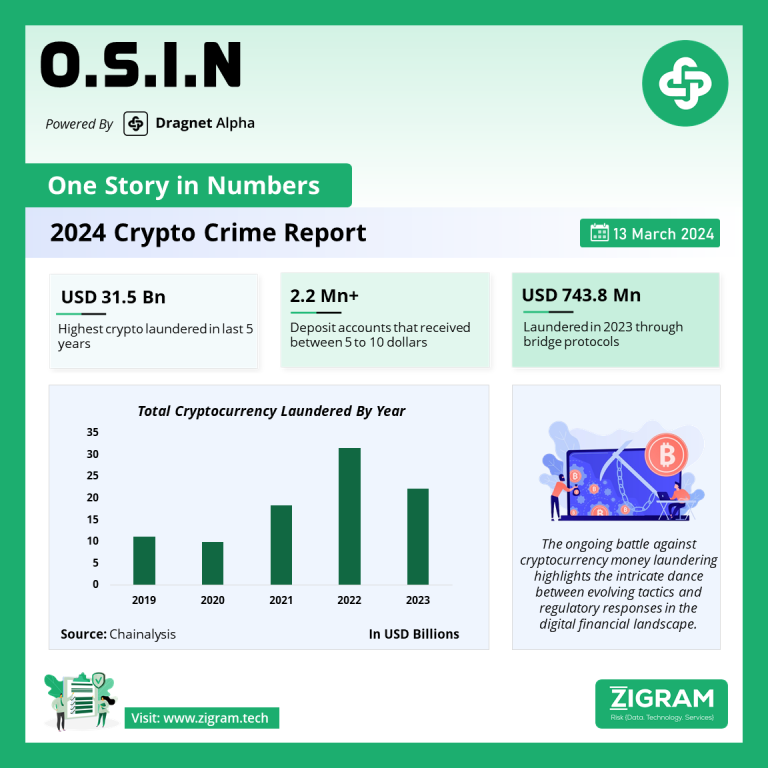Published Date:
Chainalysis released a report on Crypto Crime in 2024. It gives us insight into money laundering and other crimes associated with crypto-based transactions.
The goal of money laundering, within the realm of cryptocurrency-based crime, pivots on the intricate art of obscuring the criminal roots of funds, rendering them accessible and spendable without raising suspicion. This clandestine dance unfolds across a multifaceted landscape of intermediary services and fiat off-ramping avenues, each serving as a node in the intricate network of illicit financial maneuvers. Intermediary services, ranging from personal wallets to decentralized finance (DeFi) protocols, act as the clandestine vaults for ill-gotten gains, shrouding their origins through convoluted on-chain transactions. Fiat off-ramping services, comprising centralized exchanges, peer-to-peer (P2P) platforms, and crypto ATMs, stand as the final frontier where cryptocurrencies metamorphose into tangible cash, completing the laundering cycle. However, the efficacy of these services in tackling money laundering varies vastly, with centralized exchanges wielding the power to freeze suspicious funds, while DeFi protocols operate beyond such regulatory constraints, albeit with heightened transparency. Yet, the decentralized nature of DeFi protocols inadvertently exposes their Achilles’ heel, enabling blockchain analysts to trace the trail of laundered funds with relative ease, unlike the opaque corridors of centralized counterparts. Moreover, the eradication of illicit services facilitating money laundering remains contingent upon the efficacy of law enforcement interventions or legal avenues, underscoring the perpetual cat-and-mouse game between regulators and crypto criminals. Notably, token issuers emerge as unlikely gatekeepers in the battle against financial malfeasance, as exemplified by stablecoins like USDT and USDC, equipped with functionalities to freeze assets associated with illicit activities, thereby disrupting the money laundering supply chain.
Against this backdrop, delving into the key crypto money laundering trends of 2023 reveals a nuanced narrative of shifting dynamics and evolving strategies. Despite an overall decline in crypto transaction volume, the magnitude of money laundering activities plummeted even further, signaling a recalibration within the clandestine ecosystem. Centralized exchanges retain their hegemony as the preferred destination for illicit funds, albeit with a marginal decline in their share, juxtaposed against the burgeoning influx towards DeFi protocols, reflective of the latter’s meteoric rise in prominence. This seismic shift underscores the symbiotic relationship between technological advancements and criminal ingenuity, as crypto criminals adapt their modus operandi to exploit emerging avenues while evading regulatory scrutiny. Moreover, the diversification of laundering avenues, evidenced by the increased flow towards gambling services and cross-chain bridges, underscores the inherent resilience of illicit actors against enforcement mechanisms.
Zooming in on specific criminal cohorts unveils a mosaic of divergent trajectories, epitomized by the surge in funds channeled through cross-chain bridges from stolen wallets, or the burgeoning nexus between ransomware and gambling platforms. Such divergent patterns underscore the heterogeneity of crypto crime and the imperative for targeted interventions tailored to distinct threat vectors. Furthermore, the concentration of money laundering activities at fiat off-ramping services epitomizes the convergence of anonymity and liquidity, catalyzing a select cadre of platforms to assume outsized significance in the clandestine economy. Yet, a closer inspection at the deposit address level unveils a paradoxical trend, characterized by a divergence from concentration towards dispersion, as crypto criminals scatter their activities across a broader spectrum to mitigate the risk of detection.
In essence, the battle against crypto money laundering unfolds as a high-stakes chess match between regulators armed with evolving regulatory frameworks and tech-savvy criminals adept at exploiting regulatory blind spots. As the contours of financial malfeasance continue to evolve in tandem with technological innovations, combating crypto crime demands a multifaceted approach grounded in proactive surveillance, regulatory agility, and international cooperation. Only through a concerted effort to dismantle the underlying infrastructure underpinning money laundering operations can the promise of a transparent and inclusive crypto ecosystem be realized, safeguarding against the nefarious machinations of illicit actors.
- #Cryptocurrency
- #MoneyLaundering
- #Regulation
- #DigitalFinance
- #CyberCrime
- #RegulatoryResponse

